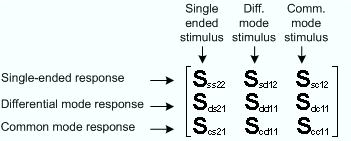Mixed mode parameters are an extension of normal mode parameters (e.g. S-parameters, impedances and admittances) for balanced measurements. The analyzer can measure mixed mode parameters as soon as a balanced port configuration is selected.
Mixed mode parameters are used to distinguish the following three port modes:
s: Single-ended (for unbalanced ports)
d: Differential mode (for balanced ports)
c: Common mode (for balanced ports)
The notation of a general S-parameter is S<mout><min><out><in>, where <mout> and <min> denote the output and input port modes, <out> and <in> denote the output and input port numbers.
 Meaning
of 2-port mixed mode S-parameters
Meaning
of 2-port mixed mode S-parameters
The mixed mode 2-port S-parameters can be interpreted as follows:

S<mout><min>11 isthe mixed mode input reflection coefficient, defined as the ratio of the wave quantities b1 (mode mout) to a1 (mode min), measured at PORT 1 (forward measurement with matched output and a2 = 0).
S<mout><min>21 is the mixed mode forward transmission coefficient, defined as the ratio of the wave quantities b2 (mode mout) to a1 (mode min) (forward measurement with matched output and a2 = 0).
S<mout><min>12 is the mixed mode reverse transmission coefficient, defined as the ratio of the wave quantities b1 (mode mout) (reverse measurement with matched input, b1' in the figure above and a1 = 0) to a2 (mode min).
S<mout><min>22 is the mixed mode output reflection coefficient, defined as the ratio of the wave quantities b2 (mode mout) (reverse measurement with matched input, b2' in the figure above and a1 = 0) to a2 (mode min), measured at PORT 2.
If <mout> is different from <min>, the S-parameters are called mode conversion factors.
Which types of mixed mode parameter are available depends on the measured device and the port configuration of the analyzer. The following examples of mixed more parameters can all be obtained with a 4-port analyzer.
DUT with only single-ended ports: No balanced port definition necessary, the analyzer provides single-ended multiport parameters.
DUT with one balanced port: Only reflection and mode conversion measurements with differential and common mode parameters.

DUT with one balanced and one single-ended port.

DUT with two balanced ports or one balanced and two single-ended ports. Both device types are fully characterized by 4x4 mixed mode S-matrices.